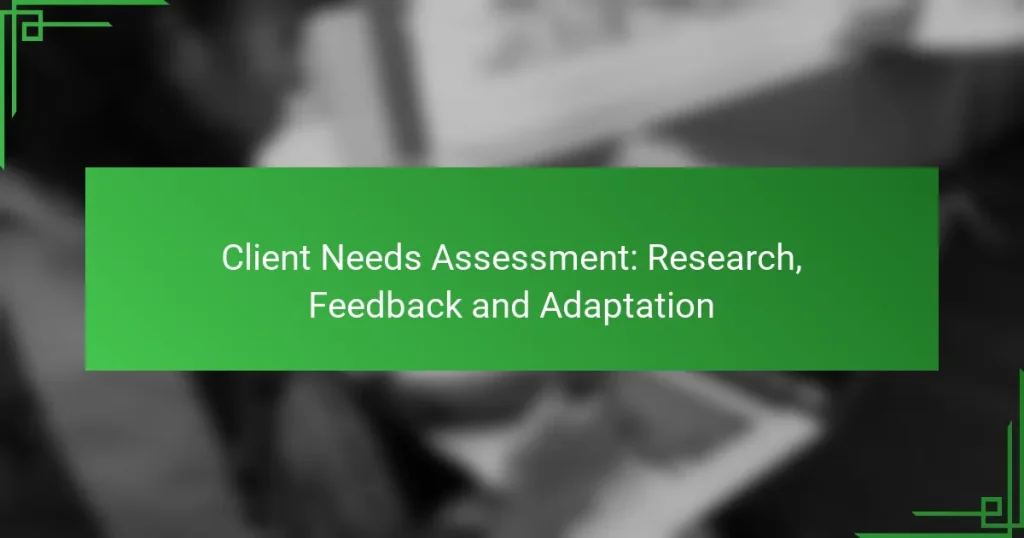A client needs assessment is a vital process that systematically identifies and understands the specific requirements and objectives of clients. By utilizing various tools to gather feedback and analyze data, businesses can align their services or products with client expectations, ultimately enhancing satisfaction and fostering stronger relationships.

How to Conduct a Client Needs Assessment?
A client needs assessment involves systematically identifying and understanding the specific requirements and objectives of your clients. This process ensures that services or products align with client expectations and can lead to improved satisfaction and outcomes.
Identify client goals
Identifying client goals is the first step in a needs assessment. Engage clients in discussions to uncover their primary objectives, whether they are looking to increase efficiency, reduce costs, or enhance customer satisfaction.
Use open-ended questions to encourage clients to articulate their goals clearly. For example, ask, “What outcomes are most important to you in this project?” This approach helps in gathering detailed insights into their aspirations.
Gather client feedback
Collecting client feedback is crucial for understanding their experiences and expectations. Utilize surveys, interviews, and focus groups to gather qualitative and quantitative data on their perceptions of your services.
Consider implementing regular feedback loops, such as post-project surveys or quarterly check-ins, to continuously gauge client satisfaction and areas for improvement. This ongoing dialogue fosters a collaborative relationship.
Analyze data trends
Analyzing data trends helps in identifying patterns and insights from the feedback collected. Look for common themes in client responses that highlight shared needs or recurring issues.
Utilize tools like spreadsheets or specialized software to visualize data trends. For example, if multiple clients express concerns about service response times, this indicates a need for operational adjustments.
Utilize assessment tools
Assessment tools can streamline the needs assessment process. Consider using frameworks like SWOT analysis or client personas to systematically evaluate client needs and align your offerings.
Online survey platforms can also facilitate data collection and analysis. Tools like SurveyMonkey or Google Forms allow you to create tailored questionnaires that can be easily distributed to clients.
Engage stakeholders
Engaging stakeholders is vital for a comprehensive needs assessment. Involve team members, partners, and clients in discussions to gather diverse perspectives on client needs.
Organize workshops or brainstorming sessions to facilitate collaboration among stakeholders. This inclusive approach ensures that all relevant voices are heard, leading to a more accurate understanding of client requirements.

What Tools Are Available for Client Needs Assessment?
Several tools can effectively support client needs assessment by gathering feedback and analyzing data. These tools vary in complexity and functionality, catering to different assessment needs and preferences.
SurveyMonkey for feedback
SurveyMonkey is a popular tool designed for creating surveys that collect client feedback efficiently. It offers a user-friendly interface and a variety of question types, making it suitable for both simple and complex assessments.
When using SurveyMonkey, consider utilizing its templates to save time and ensure comprehensive coverage of key topics. Aim for a response rate of at least 20-30% for meaningful insights, and keep surveys concise to encourage participation.
Typeform for interactive surveys
Typeform stands out for its engaging, interactive survey format that enhances user experience. Its visually appealing design can lead to higher completion rates, making it ideal for client assessments that require detailed responses.
Utilize Typeform’s logic jumps to tailor questions based on previous answers, ensuring relevance and clarity. This approach can help you gather more nuanced data, which is particularly useful for understanding specific client needs.
Google Forms for data collection
Google Forms is a free tool that allows for straightforward data collection through customizable surveys. It integrates seamlessly with Google Sheets, enabling easy data analysis and sharing.
When using Google Forms, leverage its collaborative features to involve team members in survey creation and analysis. Keep questions clear and concise, and consider using multiple-choice formats to simplify data interpretation.
Qualtrics for advanced analytics
Qualtrics is a robust platform that offers advanced analytics and insights for client needs assessment. It is particularly suited for organizations requiring in-depth analysis and reporting capabilities.
With Qualtrics, you can design complex surveys and utilize its powerful analytics tools to identify trends and patterns in client feedback. This tool is ideal for businesses looking to make data-driven decisions based on comprehensive client insights.

What Are the Benefits of Client Needs Assessment?
Client needs assessment provides critical insights that enhance service delivery and client relationships. By understanding client requirements, businesses can tailor their offerings, leading to improved satisfaction and loyalty.
Improved client satisfaction
Conducting a thorough client needs assessment directly contributes to higher client satisfaction. By actively seeking feedback and understanding preferences, businesses can address specific pain points and expectations.
For example, a company that regularly surveys its clients about their experiences can quickly identify areas for improvement, leading to more personalized services that resonate with clients.
Enhanced service offerings
Assessing client needs allows businesses to refine and expand their service offerings. By analyzing feedback, companies can identify gaps in their current services and innovate accordingly.
For instance, if clients express a desire for additional features or support, a business can adapt its offerings to include these enhancements, making their services more competitive in the market.
Informed decision-making
A comprehensive client needs assessment equips businesses with data that informs strategic decisions. Understanding client preferences and trends helps companies allocate resources effectively and prioritize initiatives.
Utilizing tools like surveys or focus groups can provide actionable insights, allowing businesses to make decisions based on actual client feedback rather than assumptions.
Increased client retention
By addressing client needs and improving satisfaction, businesses can significantly increase client retention rates. Satisfied clients are more likely to remain loyal and recommend services to others.
Implementing regular assessments and follow-ups can help maintain strong relationships, ensuring that clients feel valued and understood, which is crucial for long-term success.

How to Analyze Client Feedback Effectively?
To analyze client feedback effectively, utilize a combination of qualitative and quantitative methods to gain a comprehensive understanding of client needs and sentiments. This approach allows businesses to adapt their services based on real insights rather than assumptions.
Use qualitative analysis methods
Qualitative analysis methods involve examining non-numerical data such as open-ended survey responses, interviews, and focus groups. These methods help uncover deeper insights into client emotions, motivations, and experiences. For instance, thematic analysis can be employed to identify recurring sentiments in client comments.
When conducting qualitative analysis, consider using coding techniques to categorize feedback into themes. This can help in organizing thoughts and identifying patterns that may not be immediately apparent. Regularly reviewing this qualitative data can lead to actionable insights that enhance client satisfaction.
Implement quantitative metrics
Quantitative metrics provide measurable data that can be analyzed statistically. Common metrics include Net Promoter Score (NPS), Customer Satisfaction Score (CSAT), and Customer Effort Score (CES). These scores help gauge overall client satisfaction and loyalty, providing a clear picture of performance over time.
To implement quantitative metrics effectively, establish benchmarks and track changes over time. For example, if your NPS is in the low 30s, aim to improve it to the mid-40s within a year. Regularly collecting and analyzing this data can help identify trends and areas needing improvement.
Identify common themes
Identifying common themes in client feedback is crucial for understanding the broader context of client experiences. Look for patterns in both qualitative and quantitative data to pinpoint areas where clients express consistent concerns or praise. This can guide strategic decisions and service enhancements.
Utilize tools like word clouds or frequency analysis to visualize common phrases and sentiments. Regularly updating your analysis to reflect new feedback ensures that you remain responsive to client needs. Addressing these themes can significantly improve client retention and satisfaction rates.


